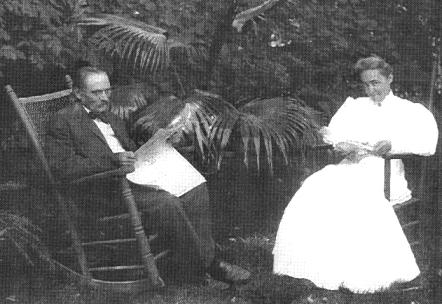|
|
|
|
|
|
(graphic intensive - please allow time to load)
|
|
|
|
|
|

Frank and Katharine Horak in the back yard of their Dodge Street house in Iowa City.
(photo from Benjamin Shambaugh Horack
)
Photo of Frank J. Horak mowing the lawn
The Shambaugh Family Papers
The University of Iowa Archives at the State Historical Society holds the papers of Bertha M. H. (Horack) Shambaugh and her husband Professor Benjamin Shambaugh. A listing of the holdings and some photos and family information are on-line at the State HIstorical Society site.
Here is the link to the site: Shambaugh Family Papers
From the February 2003 issue of "The Alumni Magazine"
[Excerpt] "Bertha Shambaugh was house proud. The wife of University of Iowa political science department head Benjamin Franklin Shambaugh, Bertha kept her House Book journals from 1902 until the beginning of June 1939.
What began as a meticulous record of dinner parties and other receptions in the house became after some years a much more thorough accounting of everything from the weather to Benjamin Shambaugh’s introductions of visiting lecturers on campus. Benjamin was chair of the university’s lecture series and as gracious a host as Bertha was a hostess."
Read more at The Alumni Magazine
From: Woman's Who's Who of America, New York: American Commonwealth Company, 1914.
SHAMBAUGH, Bertha M. H. (Mrs. Benjamin F. Shambaugh), 219 N. Clinton St., Iowa City, Ia.
Born Cedar Rapids, Ia., Feb. 12, 1871; dau. Frank J. and Katharine (Mosnat) Horack; ed. State Univ. of Ia., 1889-93 (Pi Beta Phi); m. Iowa City, Aug. 11, 1897, Benjamin F. Shambaugh, prof. of Political Science, Univ. of Iowa. Member Board of Trustees and sup't Sunday-school First Unitarian Church of Iowa City; deeply interested in the cause of liberal religion; also in development of nature study movement in public schools. Favors woman suffrage. Author: Amana, The Community of True Inspiration, 1908; The Religion of the Inspirationists (Encyclopedia of Religion and Ethics, edited by Dr. James Hastings, Edinburgh, Scotland); also magazine articles, mostly nature studies, in Youth's Companion, Outlook, Our Animal Friends, The World To-day, Midland Monthly, etc. Unitarian. Mem. Iowa Press and Authors' Ass'n. Mem. N.N. Club of Iowa City.
Excerpt from the Chicago Tribune, July 11, 2001
THE AMANA EXPERIMENT A CENTURY AGO, IOWA PHOTOGRAPHERS BEGAN
TO DOCUMENT A WAY OF LIFE THAT COULDN'T LAST
By Abigail Foerstner. Adapted from "Picturing
Utopia: Bertha Shambaugh and the Amana Photographers," by Abigail Foerstner,
February 6, 2000
"In the summer of 1890, Bertha Horack, a nineteen-year-old University of Iowa student, set out to photograph the Amana Colonies, the utopian religious community twenty miles northwest that she had visited several times before on summer visits with her family. She traveled by train with her beloved mother, Katherine Mosnat Horack, and presented the very picture of Victorian propriety. Yet everything else about the bright and ever curious Horack marked her as a woman ahead of her time. She was among the earliest social documentary photographers, mastering the behemoth view camera that had to be loaded with individual glass plate negatives measuring five-by-eight inches each. She found a market for her photographs and drawings by pairing them with freelance articles she wrote for illustrated magazines. She also published the most definitive history of the Amana Society in her 1908 book, "Amana: The Community of True Inspiration." ...........
........... Shambaugh was the first "outsider" and one of the earliest photographers who documented the Amanas. It was a time, according to Shambaugh, "when there was still an effort to maintain Amana's circle of seclusion." Community elders ordinarily upheld the inspired testimony that had placed photography among the worldly vanities to be shunned. Because other communal societies also discouraged photography, hers is a rare documentary of nineteenth-century religious utopias. Equally important, she opened the door for photography in the Amanas by both amateurs within the colonies and professionals from nearby towns. Within a few years of her project, several residents took up cameras and preserved an "insider" view of their communities. Like Shambaugh, they chose complicated, but optically peerless, view cameras loaded with glass plates instead of the new amateur box cameras loaded with film."